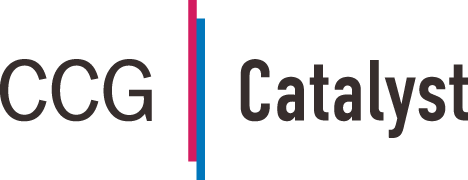Tiana Brown of CCG Catalyst on Identifying Your Business Unit’s Purpose
Listen to Tiana Brown, principal at CCG Catalyst discuss the three key steps to follow to identify your business unit’s role in supporting the overall enterprise strategy. Knowing the purpose of your business unit is a key factor in helping your organization meet its overall goals.
Podcast: Download (Duration: 11:24 – 11.7MB)
Subscribe: Apple Podcasts | Google Podcasts | iHeartRadio | Stitcher | TuneIn | Deezer
Read the full transcript here:
Tiana Brown [00:00:04] Hello, welcome to the Bank Fintech Fusion’s first episode of the big operational alignment series. I’m Tiana Brown, principal at CCG Catalyst, and today we’re going to discuss three key steps to follow to identify your business unit’s role and supporting the overall enterprise strategy. By the end of this podcast, you will have more clarity on how to become clear on roles and responsibilities, identify your functions in scope, and understand the importance of knowing how your business units production impacts other lines of business. Let’s cover these three steps towards identifying how your business units performance supports the success of the enterprise plan.
[00:00:51] Now for becoming clear on roles and responsibilities. This is so important if you’re taking on a new team or if you’re seeking clarity on what is in place. In financial services, we see a lot of change. Change in leadership or responsibility are the most common. Now, for example, a change in responsibility may be that you are given an extra product or process to oversee. There is risk to these changes as it is very rare for a new leader to be handed the outline of everything that they’re responsible for. In addition, when you are asked to take on additional work, documented procedures are not supplied in a perfect world. We all know that would be great. Taking on a new line of business or additional product scope often means that it’s time for you to get curious. What does this new role mean for your daily oversight? How does your expected performance in this role contribute to the overall organizational goals?
[00:01:46] As a leader in financial services, one of your most important deliverables is to know the scope of your work. You need to know what you’re responsible for. And so many cases, leaders understand, for example, that they run the payments team. OK, that’s great. But what are all of the things that equate to running the payments team? Until you confirm the real details, you are usually going to find out once it’s too late. Now, some of you can probably relate to this and painfully. By too late, I mean, there is a process that has been missed or you have a backlog you need to answer to. During my 10 years in banking and fintech startups, I have seen several instances where backlogs were formed due to lack of clarity and scope of the overall business flow. Now, maybe there were never any KPIs implemented. Therefore, there was zero scope of performance ever established. So how do we identify the functions that are within our scope, how do we get to learn the process and identify the details? Now simply put, this happens by asking questions, the right questions to your team. Now, especially if there’s not a documented process to reference, it’s time to meet with your teams, you can document the process along the way and I do highly recommend this. There’s always value add for internal and external purpose when it comes to documentation. Now, in my time in leadership, I was new to several teams. I enjoyed this over time as I learned what to ask when it came to understanding what I was in for and what it took for my team and I to win. I can remember going through Greenbelts Six Sigma training early on in my career and really learning about lean operations and continuous improvement. Prior to this, I was completely blind to the need for questions and performing fully within scope. I was really good at managing the surface functions, as most leaders are, but I came to find that there’s always more. That is what I’m here to help you see today. Now, if you’ve not had that training, keep listening, as I will continue to help you navigate in the direction of getting a clear vision of scope for you and your business unit.
[00:04:05] Becoming clear on what you’re responsible for, it gives you a better chance of meeting and exceeding business goals when you achieve your business goals, you are doing your part and meeting the overall enterprise goals. You must take the time and do the work to understand every function that falls within your scope. Now, once you understand the roles and responsibilities within your line of business, you need to confirm the functions that make it all happen. These are likely manual or automated processes that are performed by your team members.
[00:04:34] What are these functions? Do they make sense for your team today? When are they completed? How quickly are they expected to be completed? And in other words, what are the frequency expectations? Do you have someone or a system assigned to all of them? Now, if not, what’s missing? In Episode two, we dove deep into risk exposure on incomplete process. Identifying the functions are key because functions are what drives performance, if you do not have a true measure of performance, you’re going to have a hard time gauging the productivity of your team. On the other side of this are the tasks that no longer makes sense for your team. So, for example, do you have your team reviewing something manually that you now have reporting for? Identifying useless functions such as this save time and money. Now, how does your team operate on a daily basis? Are beginning of the months lighter on productivity than your teams feel a sense of pressure at the end of the month. Behavior such as this are key indicators of functions that are necessary, as well as an opportunity to implement a more frequent measurement into your KPIs. I will touch on this more in Episode three. How is their productivity missing meeting or exceeding your efforts and doing your part in achieving the overall organizational goal? Now that I’ve asked a lot of questions, let me apply some context for you.
[00:06:10] OK, so if one of the overall bank goals, let’s say, is to fund at least ninety five percent of goals received on a monthly basis, then you would need to know all processes on your team that support the success of meeting this goal.
[00:06:24] So, for example, this could be successful documentation intake and review, approvals for underwriting, transfers for sign off and meeting funding cutoff times. Just in these steps alone, there’s a lot of risk. So for documented intake and review, you would want to be sure that each employee understands and follows what to look for. For approvals from underwriting, you want to make sure you are aligned with compliance and regulatory expectations. For transfers to sign off within cut-off, you will want to be sure that all prior steps are followed to ensure accurate loans are funded and that everyone on your team is aware of cutoff time guidelines and details. Once you identify these functions, you’ve created a solid foundation for your business unit success. This is a process you can follow for each process well within your scope. Now for understanding how your business units performance impacts other lines of business, you must know that in financial services past, present and future, most areas of banking operations impact each other, especially as we are focused on the back office functions. It is rare to operate in a space where your work is siloed. Just to give you some context, I’ve managed in back operations in multinational banks and fintechs and what you would deem as the most entry level of functions have a huge impact on the overall enterprise performance goals. If the mailroom does not process efficiently and accurately, this could impact revenue. It is so important for each line of business to thoroughly understand how your role contributes to the overall success of the organization.
[00:08:14] This sounds very simple, but often missed by so many in leadership.
[00:08:20] I’ve witnessed where service level agreements were missed because the receiving team never communicated their deadlines and how they needed the efforts of other teams to meet these goals, whether they missed opportunities on loan sales or month end funding, it was all a result of knowledge around full scope of business.
[00:08:41] Once these conversations took place, the back office performance improved. In episodes three and four, I will discuss further how to implement and communicate these discoveries and changes. It’s important to understand that an organization will run without all this awareness, but the questions are for how long and how successful. And the example I just shared about missing the service level agreement, this was a twofold opportunity and you may be experiencing the same thing in your organization today.
[00:09:14] Had the receiving team been aware of their scope in meeting or exceeding funding goals, they would have been able to communicate to other teams what they needed to help achieve these goals.
[00:09:24] I challenge you to think about the scope and purpose of your current business unit.
[00:09:30] What functions you oversee and how your team’s impact other areas of your organization? To take it a step further, you can even think about how another team is impacting you by their performance. Take note that communication between lines of business can go both ways, you can let your receiving team know about the work you are sending over or in a lot of cases, you can and should be communicating to the team that sends work over to your team. I’ve seen instances where as a result of miscommunication by customer service agents to clients, accounting ended up booking losses at the end of each month. This happened in two different organizations, which shows true that we often must communicate frontwards and backwards once we confirm our functions and how we should be operating. If we are seeking to understand our role and need organizational goals, we will become more open to gaps in process. These examples are meant to share real life perspectives and help you connect with some possible improvements needed in your organization.
[00:10:41] I hope today that I’ve been able to provide you with more insight on how to get clear on the roles and responsibilities of your business unit, identifying your functions and scope and understanding the importance of communicating to your team members the impact that your business unit performance has on the overall areas of the business. Thank you for listening to today’s podcast. If you enjoyed this topic and are interested in learning more about the bank operational alignment, please subscribe to our Bank Fintech Fusion Channel. Again, I’m Tiana Brown, principal at Catalyst, and I’ll see you next time.
Home » Tiana Brown of CCG Catalyst on Identifying Your Business Unit’s Purpose





